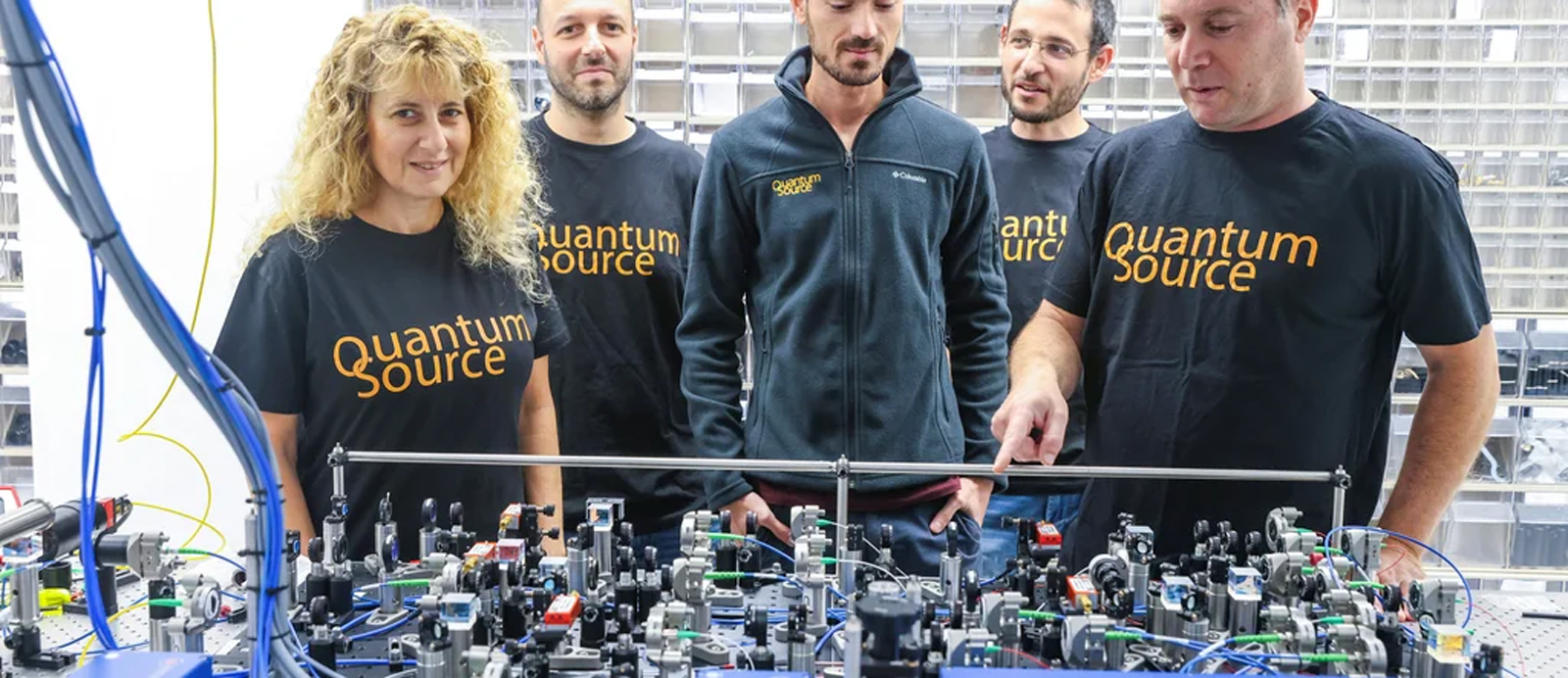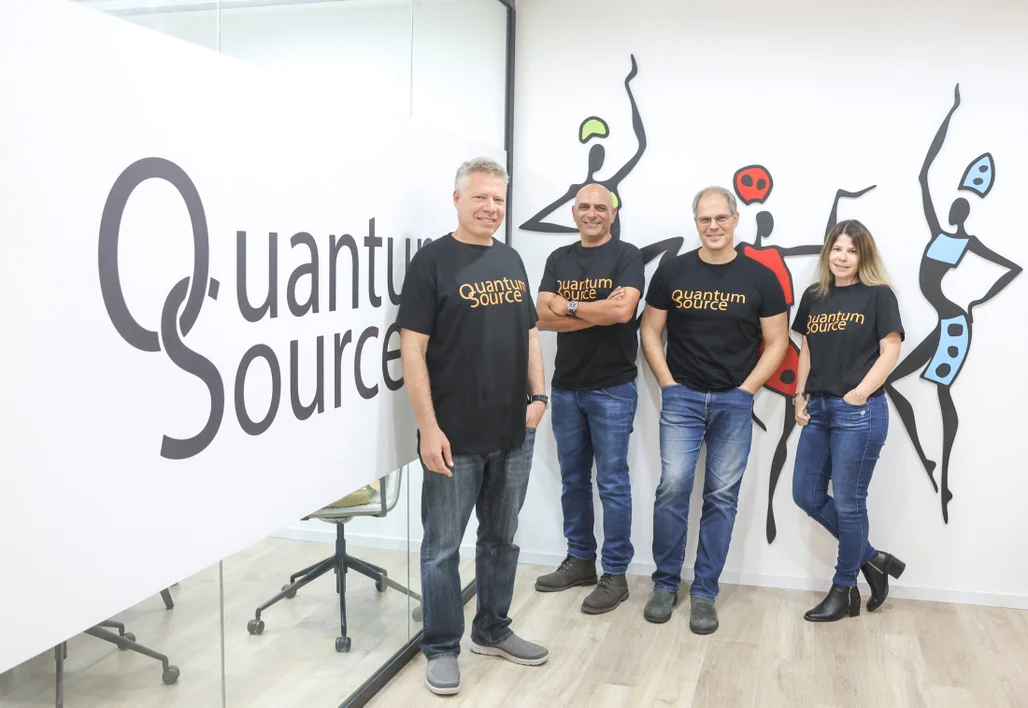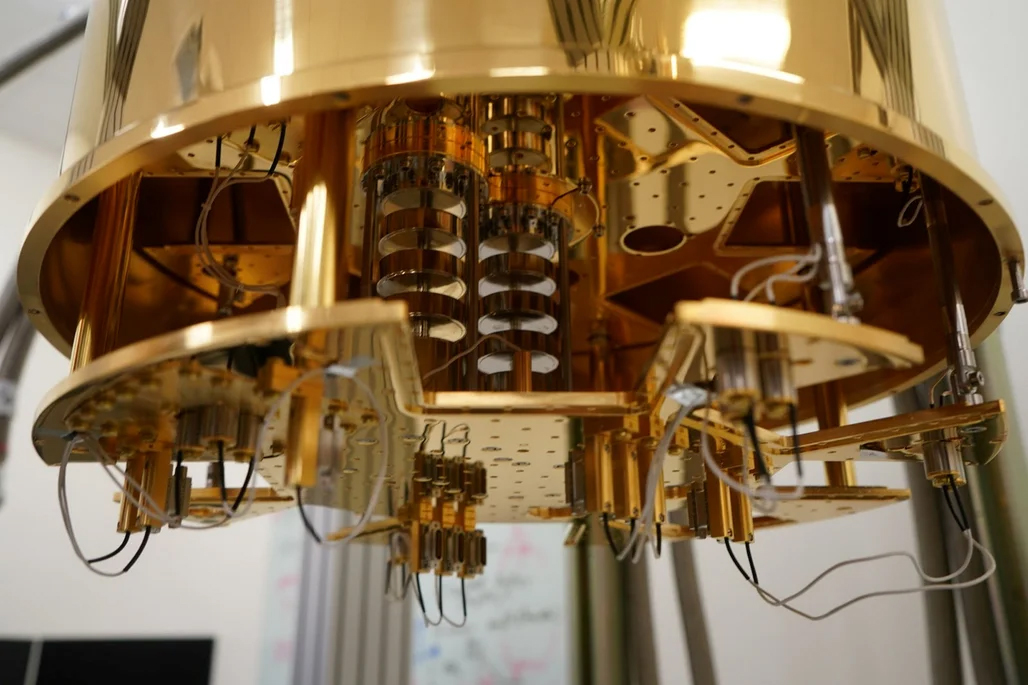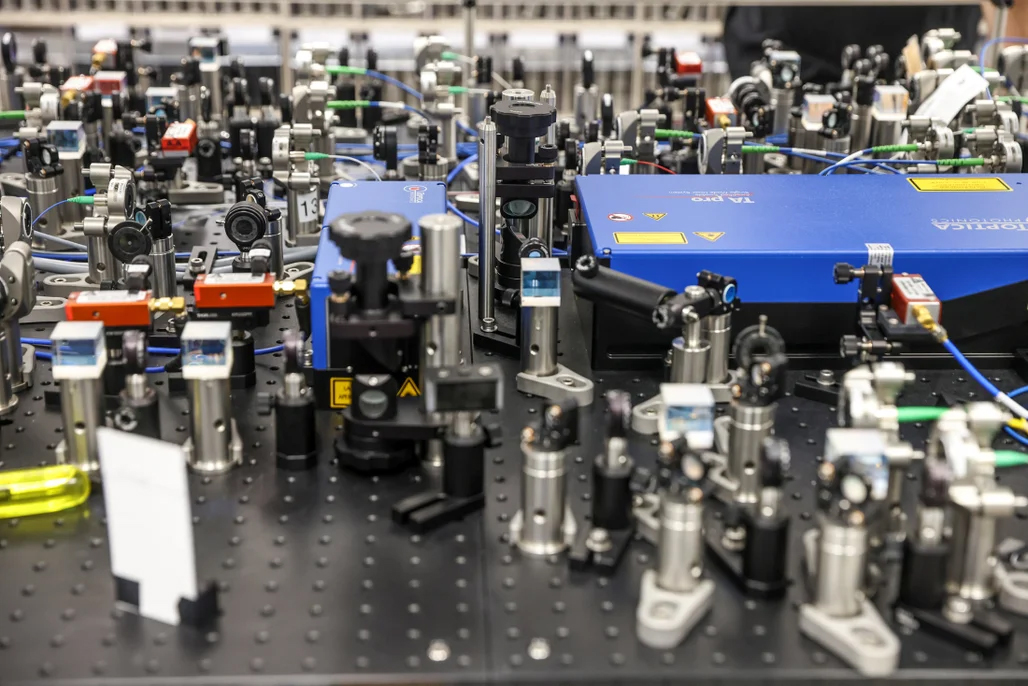
“Dan, we have to talk.” These were the words Prof. Barak Dayan had for his old army buddy, high-tech entrepreneur Dan Harash, when they met at a class reunion three years ago. Dayan, head of the quantum optics laboratory at the Weizmann Institute of Science in Rehovot, was excited. He had recently realized that a breakthrough achieved in his lab may remove key physical obstacles facing researchers and companies seeking to develop a quantum computer. “We realized that we were sitting on gold,” he recalls.
This conversation led to the inception of a startup that seeks to shake an entire industry and redefine what can be done with a computer. Quantum Source, founded under a year ago and being revealed here for the first time, seeks to be the first company in Israel to develop a new type of quantum processor, which will be at the heart of a fully functional and extremely powerful photonic quantum computer. It is located in a small office at the Rehovot Science Park, within walking distance of the lush lawns of the Weizmann Institute, where engineers and physicists labor on the joint mission.
"We realized that if we succeed, we can become the cornerstone of the revolution"
The risks are palpable, the technological challenges are great, global competition is at a fever pitch – and there is no certainty that the mission will indeed succeed. But the potential is clear: “If we succeed, we’ll be the basis for humanity’s next computer revolution,” says Dayan, a co-founder serving as chief scientist of the firm, and quickly corrects himself: “Sorry, Oded doesn’t like it when I say ‘if.’ I meant – when we succeed. When we succeed, it will be a success on the scale of Intel.” Oded Melamed, co-founder and CEO, sitting beside him during the interview conducted at the company’s offices, smiles and concurs: “It could be a real game-changer.”
Quantum Source is the product of an unusual mesh of academic quantum physics research and the Israeli computer chip development field. Dayan is a graduate of Talpiot (the IDF’s elite academic training program) and eight years of service at the Defense Ministry, in the field of electro-optic systems development. “As I approached 30, I decided to switch to doing science,” he says.

“I realized that state security is like brushing your teeth – you have to save the country all over again every morning. Science is forever.” After earning a doctorate from Weizmann Institute he went to the California Institute of Technology for postdoctoral work. When he returned to Israel he opened the quantum optics laboratory.
He knew precisely what he was doing when he reached out to Harash. His friend was a founder of the Israeli chip developer Provigent, which the U.S. chipmaker Broadcom bought about a decade ago for at least $300 million. Harash knew the potential of quantum computing, but also the problems and obstacles of the field. He looked into the subject and concluded that Dayan’s technology was commercially viable, but more than a few tests were still required. Through a common acquaintance the two joined with Gil Semo, one of the top figures at Apple Inc.’s Israeli research and development center. About a year ago, the three arrived at the door of Melamed, another veteran chip executive, one of the founders of Altair Semiconductor, which was sold to Sony in 2016.
Melamed was already well acquainted with the field of quantum computing, and had already been involved in a separate venture in the field, abandoned after the technology failed to show enough promise. Melamed was skeptical. “This bunch comes to my home to consult about starting a venture. They tell me about the idea – and it sounds completely delusional,” he recalls. “It was clear to me that this is more complicated, by several orders of magnitude, than anything I, or any of the others, had ever done before. More complicated than any chip we’ve ever developed.”
After meticulous and lengthy tests and consultations, Melamed was finally convinced that the idea was possible, and agreed to come on board as CEO. “The decision to join only made me more critical. But we realized that if we succeed, we can become the cornerstone of the revolution.”
The four founders’ next step was to raise funds. To their surprise, the first investors they met leaped at the opportunity. “This was the quickest round of fundraising I ever did, by far,” Melamed says. Dayan laughs: “They told me in the beginning that I was embarking on a long and hard journey of fundraising. Neither hard, nor long.” The company raised a seed round of $15M, lead jointly by venture capital funds Grove Ventures, Pitango First and Eclipse Ventures. Eyal Itzkowitz, Dov Moran and Seth Weinroth joined the board. In addition, the company received a two-year grant of 3 million shekels ($850,000 at current exchange rates) from the Israel Innovation Authority.
"They told me in the beginning that I was embarking on a long and hard journey of fundraising.' The company raised $15M after their first meetings with investors"
One of the reasons for the quick decision is that to investors, this is a dream team: A scientist bringing serious technology, developed for years at the Weizmann Institute, alongside seasoned executives with technological and business know-how in the fields of chips and computers, who know how to develop complex products from scratch and bring them into market. “Another reason people were interested in us is that our success means we will hold a trump card – and then the sky is really the limit,” Melamed adds.
After completing the fundraising and signing a commercialization deal with Weizmann for the use of the technology developed there, the company launched in October 2021. Today it employs 25 people, 15 of whom hold doctorates. Their degrees are from Israeli universities as well as American academic powerhouses such as Yale, Columbia, MIT, Caltech and Harvard. Their backgrounds are diverse: Quantum scientists, physicist, mathematicians, chip and system engineers as well as specialists in the relatively new area of silicon photonics - the development of microchips based on optic circuits.
Revolutionizing entire industries
The field in which Quantum Source competes is not devoid of competition. Even though for decades most quantum research and development took place in academia and government research institutes, in recent years there are more and more private companies and startups trying to step into this space and develop practical quantum applications. Tven giants like Amazon, Google, IBM and Microsoft are investing in the field.

Quantum computing, which is based on the principles of quantum mechanics, takes as its basic unit not a bit, but rather on so-called qubits (quantum processing units.) Unlike the binary “two states” of either/or on which current computers are based – either 0 or 1 – the quantum computer is based on the combinations of 0 and 1.
A quantum computer is not necessarily stronger or faster than a regular computer, but there are certain mathematically complex tasks that even the most powerful normal computer cannot handle, while for a quantum computer would be mere child's play.
"Take cracking encryption, for example," Dayan explains. "It is said that a classic computer cracks 100-bit encryption in an hour. Every 8 bits you add doubles the required time. So it's enough to go up to 1,000-bit encryption, and a regular computer will already need the equivalent of 1,000 times the age of the universe. But if a quantum computer cracks 100-bit encryption in one hour, then it will crack 1,000-bit encryption in three hours. That is, three hours compared to 1,000 times the age of the universe. It makes the impossible possible."
The presumption is that such computing capabilities will revolutionize entire industries: drug development, new material discovery, simulations, financial calculations, climate change forecasting and more. This is the holy grail of the computing world today.
Of course, for now all this is theoretical, wishful thinking: There are enormous additional technical obstacles, and also debate over whether it is even possible to reach the goal. While there are quite a few operating quantum computers in the world, most of them are small, with tens or hundreds of qubits, and therefore have very limited capabilities and are used mainly for research and development – they do not yet have concrete applications. They suffer from high instability and error rates and are susceptible to disturbances. The people at Quantum Source believe they have found the solution to the problem, the route that in a few years will lead to the development of a large, powerful, useful and stable quantum computer, with millions of qubits.
Today, as Melamed explains, the technology of most first-generation quantum computers is based on materials (superconductors, trapped ions or so-called cold atoms). "We know how to implement them, so you see a lot of them. The problem is with the scale-up: How do you turn such a computer into a big computer, with millions of qubits, so that it can solve real-use algorithms. That is a problem that hasn't been resolved. It's clear that when this happens, evolutionary change will not be enough. We'll need a new, different technology that will make this significant leap possible."

They believe that this new technology is a photonic quantum computer. Instead of material, such a computer is based on photons, light particles. "A photonic quantum processor is the technology that we believe is the leading candidate to create the large second generation of quantum computers," Melamed says.
There are a few other companies that believe it is possible to leap over the current generation of quantum computers and build an effective photonic quantum computer, with error correction, and millions of qubits. The most prominent among them is the Silicon Valley-based PsiQuantum, which last year raised $450 million, based on a company valuation of $3 billion (from investors including BlackRock and Microsoft), making the company one of the hottest and most promising names in the field. Alongside it are companies like the Canadian Xanadu as well as ventures in Europe, Japan and China. "Our assessment is that more money has been invested in the photonic effort than any other effort in the quantum market," Melamed says.
Scaling quantum
Quantum Source is also developing a photonic quantum processor, and compared to the other companies is still in its infancy. But the company's entrepreneurs believe that the technology developed in Dayan's lab will make it possible to get ahead of the pack and reach the finish line first – by overcoming a major hurdle facing the other companies: the difficulty of creating quantum entanglement. Entanglement is a complex key concept in the world of quantum computing. In a very rough abstraction entanglement can be understood as a connection between two particles that causes them to behave in a coordinated manner. Entanglement is what makes the creation of a qubit, the unit of quantum processing, possible. "Entanglement is the fuel of quantum computing," Dayan explains. "Producing this entanglement is what enables quantum computing. When I have 1,000 cubits that are entangled with each other, I can test a million possibilities in an effective manner."
Melamed adds that “the big problem is to create the entangled state, the connection between the photons. The method that Barak and his team developed uses just a few atoms to create this entanglement. In our estimate, Barak’s method is 50,000-100,000 times more effective than current methods of creating photon entanglement. These are obviously dramatic scales of order. When we succeed, this method will enable the core of every future photon computer, the cornerstone of a quantum photon computer as big as you like.”
At the company’s lab, within their Rehovot HQ, employees are currently busy developing an advanced microchip, producible at ordinary microchip plants. It needs no cooling, unlike extant technologies, but is placed inside a vacuum chamber. Through a combination of engineering know-how and the exploitation of physical phenomena, this chip can create effective photon entanglement, through the atom that serves as a sort of mediator. Melamed and Dayan call it “a sewing machine, sewing photons together.” The first prototypes of the processor or in production, and are scheduled to be available for testing withing the next few months.
What is the schedule? Quantum Source is leery of providing precise projections, but estimate that completion of the development of the quantum processor alone will take under five years – although obviously more time will be required to manufacture a full computer.
There are no clear answers yet to the question of how the technology will be applied on the business level, on the ground. It is clear that quantum computers will not replace traditional computers, but Melamed believes that quantum computers could serve as a sort of “accelerator” accompanying traditional and serving for very specific computing tasks. In other words, we may imagine a datacenter or super-computers, which are responsible for running ordinary processing and computation operations, as is done today, and alongside them quantum computers, to take on the specific tasks at which they have a decided advantage.
When asked what will be the uses of this technology and how it will benefit humanity, Melamed explains, “Imagine that you have a software package that can take any molecule and simulate its impact on the human body, or simulate a chemical process that could improve a battery. It means that the time needed to develop new medications, or new materials, will be reduced dramatically. Imagine that you have software that can provide accurate micro-climatic projections, and precisely predict the implications of any change you make.”
Needless to say that Quantum Source’s road to that holy grail is still long and fraught with obstacles. The distance from technology that works well in theory and lab tests, and a usable commercial product, can be great indeed. Quantum Source will have to operate for many years in R&D mode, without revenue of course, and raise more venture capital further on, to last it for years to come. All this, with the quantum field as a whole not yet fully formed, and its business models are still in its infancy. There are even some scientists who argue that quantum computing as a whole is overrated buzz and hype, and that it is not at all certain that a practical quantum computer is even obtainable. It is also possible that even if obtainable, the revolution it brings will be more modest than currently promised.
The gamble taken by Quantum Source, its entrepreneurs and its investors, may be calculated and scientifically grounded, but it represents a far greater risk compared to most startups. Many times, when a company discovers that its technology does not fit the market, it pivots in business or technology. In Quantum Source’s case, it will be much harder.
Beyond this, Quantum Source is not alone. Startups, firms, and tech giants are investing tremendous sums of money and knowledge in developing various sorts of quantum computers. Even in Israel, Quantum Source may be the first to be developing a quantum processor, but not the only one anymore. Several groups of Israeli entrepreneurs are currently organizing to launch companies that will also attempt to develop quantum hardware and processors.
Melamed argues that it is entirely possible that the future will see several types of quantum computers based on different technologies, and “maybe there is something hiding that we are unaware of, but at the moment my partners and I haven’t seen another, better method, to achieve a large-scale computer with practical computing capabilities.”
Dayan says that, “starting the company was the most frightening decision I ever made. I feel the weight of history, and pardon me the bombast. I have a few more decades on earth, and I’m not going to waste them. It’s not easy to be committed to something like this, but the only thing that scares me more is being 90, looking back, and saying ‘I could have.’ We embarked on this journey with great understanding of the difficulty – but also of the potential.”
